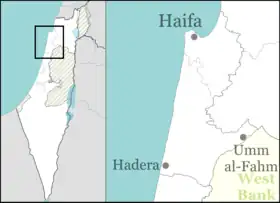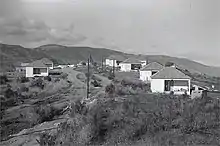Kiryat Tiv'on
קִרְיַת טִבְעוֹן كريات طيفون | |
|---|---|
Local council (from 1958) | |
| Hebrew transcription(s) | |
| • ISO 259 | Qiryat Ṭibˁon |
| • Also spelled | Qiryat Tiv'on (official) |
 View of Kiryat Tivon | |
 Kiryat Tiv'on  Kiryat Tiv'on | |
| Coordinates: 32°43′26″N 35°7′38″E / 32.72389°N 35.12722°E | |
| District | |
| Government | |
| • Head of Municipality | Ido Greenblum |
| Area | |
| • Total | 8,419 dunams (8.419 km2 or 3.251 sq mi) |
| Population (2021)[1] | |
| • Total | 18,519 |
| • Density | 2,200/km2 (5,700/sq mi) |
Kiryat Tiv'on (Hebrew: קִרְיַת טִבְעוֹן, also Qiryat Tiv'on) is a town in the Haifa District of Israel, in the hills between the Zvulun (Zebulon) and Jezreel valleys. Kiryat Tiv'on is located 15 kilometres (9.3 mi) southeast of Haifa, on the main road to Nazareth. Kiryat Tiv'on is the result of the municipal merger of several older settlements, Tiv'on (est. 1946), Elro'i (est. 1935), Kiryat Haroshet (est. 1935) and Kiryat Amal (est. 1937). On the outskirts of Tiv'on is a Bedouin township called Basmat Tab'un. In 2022 it had a population of 19,130.[1]
In the area of Kiryat Tivon, one can find the National Park and the World Heritage Site Beit She'arim, the Sanhedrin's Seat and the burial place of Rabbi Judah ha-Nasi, as well as the sculpture of Alexander Zaid, who resided in the area with his family and was murdered nearby.
History




Ancient Israel
An ancient Jewish town called Tiv'on existed in the general area. It was mentioned in the Talmud and Mishnah.[2] It is mentioned several times in Talmudic literature in connection with various sages, some of whom lived there.[3]
Ottoman Empire
In 1859, the village of Tubaun[4] was estimated to have a tillage of 22 feddans.[5] In 1875, Victor Guérin found that the village had 200 inhabitants.[6] In 1881, the PEF's Survey of Western Palestine (SWP) described Tubaun as a small adobe village, on high ground, at the edge of the wood.[5] A population list from about 1887 showed that Tuba'un had about 90 inhabitants; all Muslims.[7]
British Mandate
The 1922 census of Palestine showed that Tub'un had 151 inhabitants, all Muslim.[8]
The area was acquired by the Jewish community as part of the Sursock Purchase. In 1925 a Zionist organisation purchased 30 feddans in Kiskis (present Alonim) and Tabon (present Kiryat Tiv'on) from the Sursuk family of Beirut. At the time, there were 36 families living there.[9] In the 1931 census Tabun had a population of 239, still all Muslim, in a total of 48 houses.[10] From 1931, and lasting several years, the Jewish Agency struggled to evict the tenant farmers from Tabaun, from the land which was to become Tivon.[11]
In the 1945 statistics, al Tivon (Alonim) (previously Qusqus Taboun) had 370 Muslim and 320 Jewish inhabitants, with a total land area of 5,823 dunams.[12][13] Of this, 141 dunams were used for plantations and irrigable land, 2,038 for cereals,[14] while 3,644 dunams were classified as non-cultivable land.[15]



Modern Israel
Kiryat Tiv'on was established in 1958 merging three small villages Tiv'on (founded in 1947), Kiryat Amal (founded in 1937) and Elro'i (founded in 1935). Kiryat Haroshet, founded by a rabbi from Jablona, Poland who settled there with his followers in 1935, became part of Kiryat Tiv'on in 1979.
Tiv'on was built on land owned by a British Jewish couple who bought the land in early 1945. It was later developed by the Jewish National Fund based on an urban plan drawn up by Alexander Klein, a Russian Jewish architect who was commissioned by the Jewish National Fund.[16]
The symbol of Kiryat Tiv'on is the cyclamen, a flower that grows between the rocks, reflecting the town's appreciation of nature and its efforts to preserve the landscape and safeguard the environment.[17]
Population
According to data from the Israel Central Bureau of Statistics (as of the end of September 2020, an estimate), there are 18,312 residents living in Kiryat Tivon. The population has been growing at an annual rate of 3%. The percentage of those eligible for a matriculation certificate among 12th-grade students in the academic year 2020-2021 was 84.1%. The average monthly salary of an employee in 2019 was 12,598 NIS (national average: 9,745 NIS).[18]
Characteristics of Kiryat Tivon
Kiryat Tivon is characterized by low-rise construction, tree groves, and extensive gardening. This style attracts strong population groups, so there is an inclination to preserve it while developing and constructing new neighborhoods. Additionally, there is a council decision not to establish industries or factories with air, water, or ground pollutants. The settlement was an early adopter of recycling back in the 1980s, at a time when most of Israel lacked infrastructure for waste disposal, waste separation, recycling facilities, and more. In every household in the settlement, there were two bins - one for regular waste and one for wet waste, collected on different days. However, research conducted by a local newspaper found that due to negligence, people did not separate the waste properly, and both bin contents were thrown into the garbage truck, effectively rendering the double bin system redundant.
climate
The climate conditions in the area are considered comfortable. The annual average temperature difference is 19 Celsius degrees. The average temperature between day and night is 10 degrees Celsius. The average humidity is 65% - 70%. The number of sunny days per year ranges from 20 to 40 days, and heavy overcast days range from 3 to 6 days. The average annual rainfall is 700 millimeters.[19]
Flora
In the hilly area within the boundaries of the settlement and its vicinity, grow remnants of the Quercus ithaburensis forest, Styrax officinalis, Pistacia atlantica , a Mediterranean forest, as well as a new intensive forest of Pine trees planted by the Jewish National Fund (AKA Keren Kayemet LeYisrael). Among the Tabor oak trees stands the ancient oak tree with a trunk circumference of 5.3 meters. Benches have been placed around it as a corner of remembrance for the soldier Ilan Gabbai[20] RIP, a paratrooper officer who fell in the Second Lebanon War.
One-third of the settlement's area is covered with trees.[21]
Livelihood Sources
Since Kiryat Tivon lacks industries, factories, and many institutions, most of the residents work outside of Tivon.
Education
- Oranim Academic College[22]- For educational studies.
- Ramat Hadassah youth village [23] - founded by the Jewish Agency for Israel.
- Kfar Tikvah, village for disabled people.
Landmarks
The town is best known for the national park, Beit She'arim, which borders it on the southwest. Beit Shearim was an important Jewish spiritual center and necropolis during the Roman period, and was once the seat of the Sanhedrin.
Notable residents
- David Elazar, former Chief of Staff of the Israel Defense Forces
- Mordechai Gur, former Chief of Staff of the Israel Defense Forces
- Tal Friedman, actor and comedian
- Yoni Eilat, actor and singer
- Tomer Hemed, footballer
- Frank Lowy, Australian businessman and third richest man in Australia as of 2016
- Rina Mor, lawyer, Miss Israel 1976 and Miss Universe 1976
- Hilla Nachshon, TV host, model and actress.
- Sara Netanyahu, wife of Israeli prime minister Benjamin Netanyahu
- Eliezer Smoli, children's author
Twin towns – sister cities
Kiryat Tiv'on is twinned with:
 Braunschweig, Germany[24]
Braunschweig, Germany[24] Compiègne, France
Compiègne, France Čakovec, Croatia
Čakovec, Croatia
See also
References
- 1 2 "Regional Statistics". Israel Central Bureau of Statistics. Retrieved 22 February 2023.
- ↑ "Kiryat Tivon Excursion to the Giant Oak and Mastic".
- ↑ "Tivon | Encyclopedia.com".
- ↑ from tảba: to press or stamp, according to Palmer, 1881, p. 117
- 1 2 Conder and Kitchener, 1881, SWP I, p. 273
- ↑ Guérin, 1880, pp. 398-399
- ↑ Schumacher, 1888, p. 175
- ↑ Barron, 1923, p. 33
- ↑ according to List of villages sold by Sursocks and their partners to the Zionists since British occupation of Palestine, evidence to the Shaw Commission, 1930
- ↑ Mills, 1932, p. 96
- ↑ Avneri, 1984, pp. 156-7
- ↑ Government of Palestine, Department of Statistics, 1945, p. 15
- ↑ Government of Palestine, Department of Statistics. Village Statistics, April, 1945. Quoted in Hadawi, 1970, p. 49
- ↑ Government of Palestine, Department of Statistics. Village Statistics, April, 1945. Quoted in Hadawi, 1970, p. 92
- ↑ Government of Palestine, Department of Statistics. Village Statistics, April, 1945. Quoted in Hadawi, 1970, p. 142
- ↑ Revista Morashá - Artigos
- ↑ http://www.ktv.org.il/ Municipality website
- ↑ [chrome-extension://efaidnbmnnnibpcajpcglclefindmkaj/https://www.cbs.gov.il/he/publications/doclib/2022/local_authorities20_1879/945_2300.pdf "Kiryat Tivon's profile"] (PDF). Israel Central Bureau of Statistics.
{{cite web}}: Check|url=value (help) - ↑ "about Kiryat Tivon". Kiryat Tivon municipal website.
- ↑ "Ilan Gabay's memorial page". izkor website.
- ↑ "העשירים בצל, העניים חשופים: מפה חדשה מראה שהשמש לא קופחת על כולם באופן שווה". הארץ (in Hebrew). Retrieved 2023-11-07.
- ↑ "about oranim college". www.oranim.ac.il. Archived from the original on 2016-10-29. Retrieved 2016-10-21.
- ↑ "About Ramat Hadassah Youth Village". Archived from the original on 2012-08-26. Retrieved 2009-03-31.
- ↑ "Braunschweigs Partner und Freundschaftsstädte" [Braunschweig - Partner and Friendship Cities]. Stadt Braunschweig [City of Braunschweig] (in German). Archived from the original on 2012-12-01. Retrieved 2013-08-07.
Bibliography
- Avneri, Arieh L. (1984). The Claim of Dispossession: Jewish Land-settlement and the Arabs, 1878-1948. Transaction Publishers. ISBN 0-87855-964-7.
- Barron, J.B., ed. (1923). Palestine: Report and General Abstracts of the Census of 1922. Government of Palestine.
- Conder, C.R.; Kitchener, H.H. (1881). The Survey of Western Palestine: Memoirs of the Topography, Orography, Hydrography, and Archaeology. Vol. 1. London: Committee of the Palestine Exploration Fund.
- Government of Palestine, Department of Statistics (1945). Village Statistics, April, 1945.
- Guérin, V. (1880). Description Géographique Historique et Archéologique de la Palestine (in French). Vol. 3: Galilee, pt. 1. Paris: L'Imprimerie Nationale.
- Hadawi, S. (1970). Village Statistics of 1945: A Classification of Land and Area ownership in Palestine. Palestine Liberation Organization Research Center.
- Palmer, E.H. (1881). The Survey of Western Palestine: Arabic and English Name Lists Collected During the Survey by Lieutenants Conder and Kitchener, R. E. Transliterated and Explained by E.H. Palmer. Committee of the Palestine Exploration Fund.
- Schumacher, G. (1888). "Population list of the Liwa of Akka". Quarterly Statement - Palestine Exploration Fund. 20: 169–191.
External links
- New version of old self-defense group guards Jewish farmlands
- Survey of Western Palestine, Map 5: IAA, Wikimedia commons
